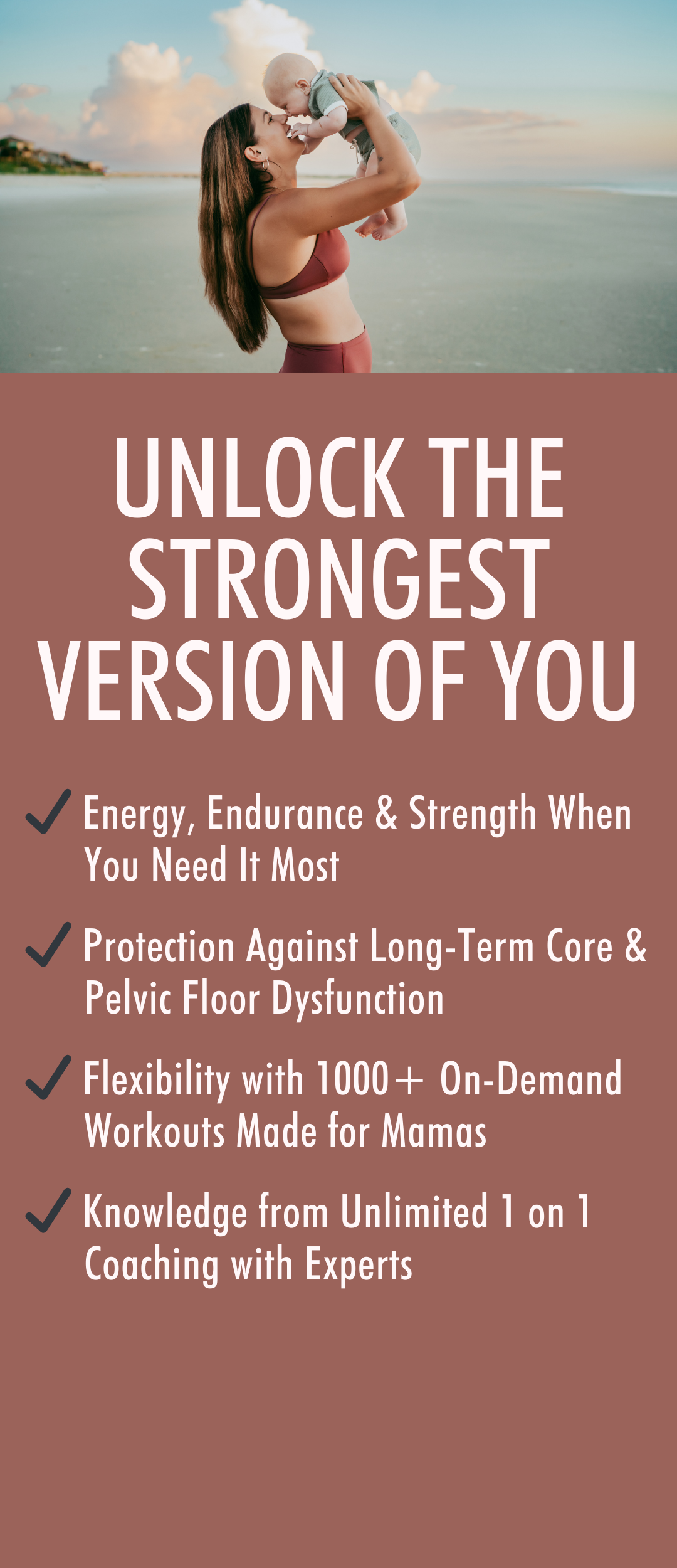How to Heal Your Pelvic Floor After Giving Birth

You don’t have to accept pelvic floor dysfunction as your new normal.
As a mom, we know your mind is flooded with opinions about pelvic floor healing.
Your family members and friends all have stories to share, too.
- Your mom still struggles with incontinence thirty years after giving birth.
- Your best friend is trying to correct prolapse.
- Many of your peers at the local running club have dropped out after birthing babies.
It’s true, bringing a child into the world comes with sacrifice.
But your body and favorite physical activities don’t have to be part of that sacrifice.
Your core and pelvic floor are designed to handle the extra stress of pregnancy and childbirth. With the right science-driven tools and women-informed methods, you absolutely can exist in a future with zero pelvic floor dysfunction.
Understanding the Pelvic Floor and How It Functions
The pelvic floor is a group of muscles, ligaments, and tissue that’s found between the pubic bone and tailbone (or coccyx). It’s made up of three different layers that promote sexual pleasure, support bladder function, and hold up your pelvic organs (the bladder, bowels, and uterus).
The pelvic floor is heavily stressed during late-trimester pregnancy and birth. These muscles have to move out of the way during the pushing phase of labor and allow your uterus to take over. It’s common to lose connection with your pelvic floor or feel temporary tightness after birth.
But just because your pelvic floor goes through a lot during pregnancy and birth doesn’t mean it’s unprepared to handle the increased demand. Pelvic floor exercises that promote strength and length in the pelvic floor can help you return to everyday activities quickly — without long-term side effects of pelvic floor dysfunction.
What Symptoms Can Pelvic Floor Exercises Help Reverse?
Pelvic Floor Exercises for Incontinence
Peeing when you run, jump, or sneeze is probably the most common symptom of pelvic floor dysfunction. The pelvic floor muscles not only hold your bowels and bladder in place but also control how you use them. Incontinence is so common after birth that it’s almost expected — and your medical provider may warn that it’s a long-term side effect.
At The Bloom Method, we want to remind you that incontinence is not normal and can greatly impact your quality of life. Beginning pelvic floor exercises immediately after birth can help restore natural function.
Pelvic Floor Exercises for Prolapse
When your pelvic floor muscles are weakened or injured, they may struggle to hold your pelvic organs in place. Your bladder and uterus could slip further down in the body, resulting in a slight bulge around the vagina.
Yes, it sounds scary. But remember, your body is prepared to handle the extra stress and changes of pregnancy and birth. Diaphragmatic breathing can help you rebuild connection and structure within your pelvic floor.
Pelvic Floor Exercises for Sexual Health
Another common symptom of pelvic floor dysfunction is painful or uncomfortable sex. This usually stems from a tight (or hypertonic) pelvic floor, which Kegel exercises can actually make worse. Painful sex isn’t normal, and it’s not something you have to “get used to.” There are many exercises you can use to lengthen and relax your pelvic floor after birth.

5 Steps to Heal Your Pelvic Floor After Birth
Step One: Harness Diaphragmatic Breathing
If you commit to just one postpartum pelvic floor exercise, let it be diaphragmatic breathing. This is a low-effort method you can use in the preconception, prenatal, and postnatal periods to connect to the pelvic floor.
With each breath, you should feel the subtle movement that naturally happens in the pelvic floor. On the inhale, pay attention to a sensation of lengthening and rebounding. On the exhale, feel as your pelvic floor activates.
Diaphragmatic breathing will teach you to differentiate between the pelvic floor being engaged and supported versus opened and lengthened. Recognizing the difference is foundational to healing your pelvic floor after giving birth.
Step Two: Learn to Lengthen the Pelvic Floor and Promote Balance
Carrying the extra weight of a baby and then going through the pushing stage of birth can send your pelvic floor reeling. It’s common to feel spasms or temporary tightness (this is sometimes called a hypertonic pelvic floor).
The goal of pelvic floor lengthening is to reverse the physical trauma and cultivate a feeling of safety and relaxation. This is the exact opposite of activating and engaging your pelvic floor muscles (the sensation you feel when you practice Kegel exercises).
As you breathe diaphragmatically, you’ll notice the difference between pelvic floor release and activation. The pelvic floor needs to be able to engage on command (when lifting, coughing, or sneezing) — but it also has to be able to lengthen and release. Balancing both is crucial to optimal pelvic floor function.
This is what we mean by “pelvic floor balance.” And it’s the reason we encourage diaphragmatic breathing and a wide variety of pelvic floor exercises (not stand-alone Kegels).
Step Three: Intentional Activation
Once you understand how to lengthen your pelvic floor muscles with diaphragmatic breathing, we encourage going one step further. Our Belly Pump Technique teaches you how to intentionally activate your pelvic floor muscles when you exhale. This allows you to build muscle within your pelvic floor — activating all three layers and strengthening the tissue that holds your organs in place.
Step Four: Pelvic Floor Trainers
Once you’ve mastered these foundational techniques, you can add in pelvic floor trainers. These are devices that are inserted into the vagina and help you gain awareness of activation versus lengthening of the pelvic floor muscles.
Our favorite pelvic floor trainers are the Pirafit and Elvie. Both help you create balance with strength and flexibility by helping you detect and correct improper movements. One benefit to these pelvic floor trainers is the biofeedback they provide to your phone. You’ll get a pelvic floor assessment in real time and discover your strengths and weaknesses.
Since these devices help you contract your pelvic floor (aka, build muscle), we only recommend using them during postpartum.
Step Five: Don’t Count on Kegel Exercises Alone
We like to visualize the pelvic floor as a diamond shape. The top of the diamond stretches from the pubic bone to the tailbone, and the sides are your sit bones. When you engage your pelvic floor muscles with your breath, you’ll notice that all four points of the diamond pull together.
This activates your entire pelvic floor. On the contrary, a traditional Kegel only engages the muscles around the urethra. The goal of a Kegel exercise is to strengthen the pelvic floor muscles. But without lengthening these muscles, you can lose flexibility and promote tightness or injury.

The Bottom Line: Yes, You Can Heal Your Pelvic Floor After Birth
The reason your pelvic floor healing journey has plateaued?
It’s because you don’t have the resources to restore and support your pelvic floor on your own.
And this isn’t your fault.
It’s the result of years of under-research and misunderstanding of the female body.
At The Bloom Method, we’re changing the narrative. Our unique exercise classes target pregnancy and postpartum needs. We believe you can leave pregnancy with a stronger core and pelvic floor than ever before.





